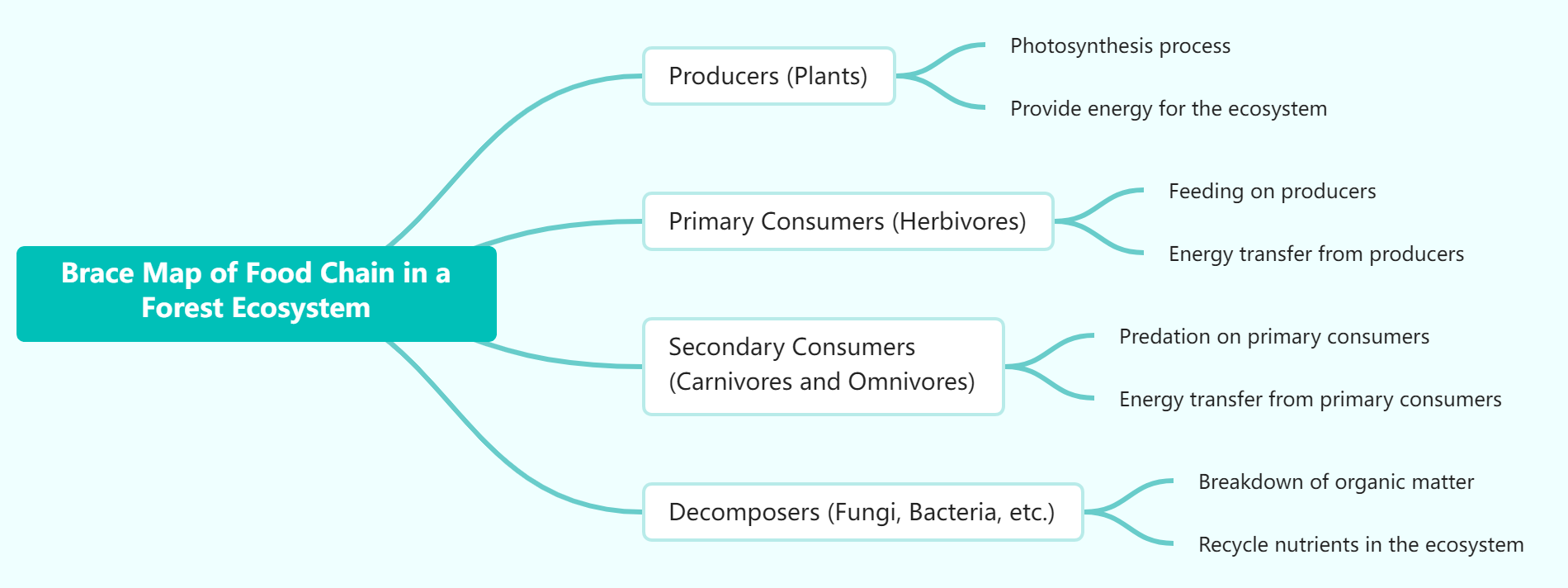
Explain Food Chain with Brace Map
The Brace Map of the Food Chain in a Forest Ecosystem delves into the intricate relationships and energy flow among various components within a forest ecosystem. Organized into four main sections, the map explores Producers (Plants), Primary Consumers (Herbivores), Secondary Consumers (Carnivores and Omnivores), and Decomposers (Fungi, Bacteria, etc.). Starting with Producers, the map highlights the photosynthesis process through which plants provide energy for the entire ecosystem. Primary Consumers, represented by herbivores, feed on these producers, facilitating the transfer of energy within the food chain. Secondary Consumers, including carnivores and omnivores, engage in predation on primary consumers, further contributing to energy transfer. Lastly, Decomposers play a vital role in breaking down organic matter and recycling nutrients within the ecosystem. This Brace Map provides a comprehensive visual guide, offering insights into the dynamic interactions and dependencies that sustain life in a forest ecosystem, emphasizing the role of each component in maintaining ecological balance and energy flow.
Balance of of Nature with Food Chain
The food chain in a forest ecosystem is of paramount importance as it reflects the delicate balance of nature, sustaining life and maintaining ecological harmony. Producers, primarily plants, initiate the chain by converting sunlight into energy through photosynthesis. Herbivores, as primary consumers, feed on these plants, facilitating the flow of energy to higher trophic levels. The subsequent tiers, including carnivores and omnivores as secondary consumers, engage in predation, further influencing energy distribution. Integral to this system are decomposers, which break down organic matter, recycling nutrients and completing the cycle. The balance of the food chain ensures that no single species proliferates uncontrollably, preventing ecosystem disruption. This equilibrium promotes biodiversity, resilience, and overall health within the forest ecosystem. Human activities that disrupt this balance, such as deforestation or overexploitation of certain species, can have cascading effects, emphasizing the need for conservation efforts and sustainable practices to preserve the intricate web of life in forest ecosystems. Understanding and maintaining the delicate balance of the food chain is fundamental to the health and longevity of these vital natural environments.
Power of Brace Maps and VP Smart Board in Concept Communication
The Brace Map emerges as a powerful ally in elucidating intricate concepts like the food chain, offering a visual scaffold that enhances understanding. Its structured layout facilitates a step-by-step exploration of the relationships between different components in a clear and digestible manner. To further elevate the creation of insightful Brace Maps and other visual aids, Visual Paradigm Smart Board stands out as an exceptional tool. With its user-friendly interface and a wealth of features, Visual Paradigm Smart Board empowers users to seamlessly design and customize Brace Maps, transforming complex ideas into engaging visuals. Elevate your communication and visualization skills with Visual Paradigm Smart Board, a dynamic platform that simplifies the creation of visually compelling mind maps and promotes effective knowledge sharing.